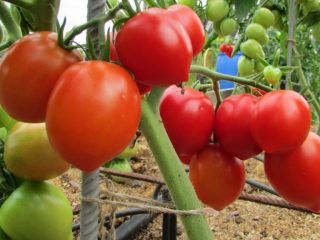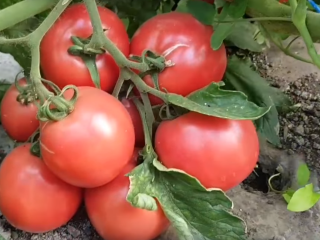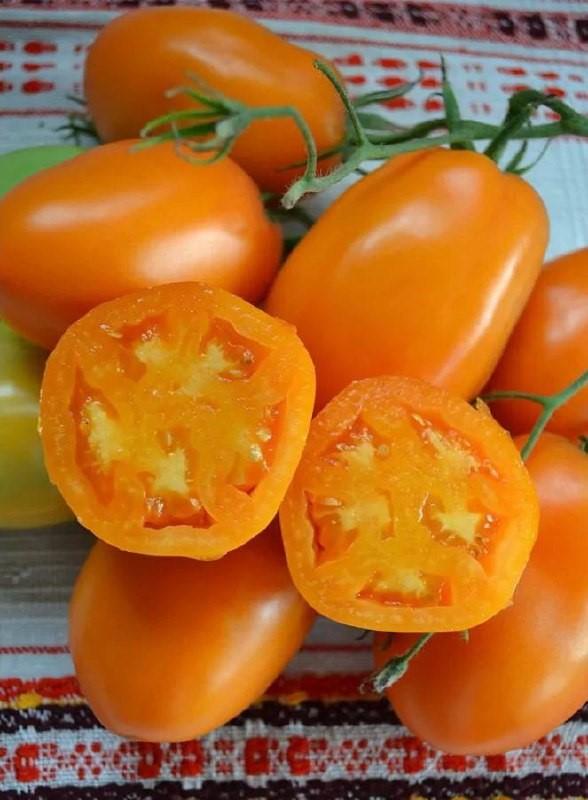Content
Fans of exotic varieties will certainly like the Bananchik tomato, a domestic selection. It became famous not only for its unusual shape, but also for its excellent taste. It will be useful for gardeners to get acquainted with its characteristics, care features and use of the crop.
History of selection
The originator of the Bananchik variety is the well-known agricultural company Aelita LLC. The tomato has been approved for cultivation since 2015. Since then, it quickly became in demand and loved among vegetable growers. The Bananchik variety can be grown both in open ground and under film cover.

Bananachik tomato seeds have 100% germination, germination energy and viability, and give a high yield
Description and characteristics of Bananchik tomatoes
The vegetable crop Banana is a tall plant from 1.6 to 1.8 m in height. Greenhouse tomato bushes often reach 2.5 m, reaching the ceiling of the room. This is explained by the indeterminate type of growth, that is, unlimited.
The bushes have an average density of long, intense green leaves. The root system is highly developed and powerful. During the flowering period, small bright yellow flowers appear.
The number of fruits in each flower cluster is up to nine pieces. Experienced farmers recommend forming a tomato into one stem.
The pulp is dense and dry. The taste is sweet, without sourness, with pleasant fruity notes. The skin is elastic, but unobtrusive to eat.

Bananachik tomato fruits are similar to bananas, hence the name of the variety
When it ripens
You can taste ripe Bananachik tomatoes 116-120 days after planting the seedlings in the ground. This period of ripening is considered late. Depending on the climate and growing conditions, fruit harvest lasts from mid-July to early autumn.
Tomato yield Bananachik
The yield of Banana tomato is high. From one square meter you can harvest 10-11.8 kg of tomatoes. If you monitor the amount of fertilizing, the fruits grow up to 12 cm in length, and the taste becomes even sweeter.
Resistance to adverse factors
This variety of tomatoes is hardy and resistant to adverse conditions. The plant is not afraid of heat and drought, and manages to produce a crop during the short and cool summer.
Growing regions
The universal variety Bananchik is grown everywhere in all Russian regions. It is unpretentious and can withstand a wide range of temperature conditions. It tolerates short-term drought well and is responsive to fertilizing.
Methods of application
The Bananchik tomato variety is distinguished by its universal use. The yellow, dense fruits are consumed fresh and processed. Their pulp is dry, so it is not suitable for juices. Tomatoes can be used to prepare twists for the winter.

Good transportability of the crop makes Banana an excellent choice for sale on the market
Advantages and disadvantages
The Bananchik variety has numerous positive reviews. It is valued by gardeners for its stable yield, plasticity, and good taste of the fruit.

Yellow tomatoes do not cause allergies and are suitable for diets and children's menus
Pros:
- strong immunity to fungal diseases;
- can grow in a greenhouse and open ground;
- bushes are medium dense and do not require special care;
- crack resistance.
Minuses:
- requires shaping and tying;
- needs late blight prevention.
When and how to plant
For the Bananchik tomato, the planting time in open ground falls in May-June. Therefore, they begin to sow seeds for seedlings in March. Pre-seed material is soaked in a weak solution of potassium permanganate. Then germinated in a damp cotton towel. And after the sprouts appear, they are planted in a nutrient substrate.
Young shoots are regularly watered with settled water at room temperature. Water is poured from a watering can under the root, being careful not to touch the stem and tender leaves.
At the age of two true leaves, the seedlings are planted in separate containers. With the arrival of warmth, the seedlings are transplanted to an open, illuminated area, but protected from the winds.
Tomatoes are planted according to a 60x50 cm pattern. There are no more than four plants per square meter.The bottom of the holes is lined with a layer of manure, but it must be seasoned so that the roots do not get burned. Plant the plants and sprinkle the roots with dry, loose soil.

The plantings are compacted with palms, watered, and then mulched with straw.
Features of care
Tomato does not require any special care. It is enough to carry out the basic procedures necessary for the plant:
- Watering. Plants are irrigated in the evening, when there is no longer sun. They especially need watering during flowering and before fertilizing.
- Feeding. The bushes are fertilized every two weeks. For this purpose, complex mineral or organic solutions are used.
- Loosening. After each watering, the soil under the tomatoes is loosened to a depth of 5 cm. The first time, loosening is carried out immediately after planting the tomato. In the future - every 10-12 days.
- Stepsonning. During the growth process, the tomato breaks off shoots that appear on the stem of the bush from the lateral axils of the leaf. If you don’t do this, the bushes will grow huge, but there will be few fruits.

Several times during the season, banana tomato bushes must be tied to a support to prevent crop loss
Prevention of diseases and pests
Tomato bushes resist most fungal diseases. The authors of the variety focus on resistance to late blight. But without additional protection, the culture becomes susceptible to this disease.
Tomato late blight manifests itself in the appearance of a white coating and small brown spots on the leaves. They curl, wither and fall off. The bushes are dying. Tomato fruits of the Bananchik variety are also damaged by late blight, including the ovaries - they become stained, become dry and hard, and smell bad.
For prevention when growing tomatoes in a greenhouse, it is necessary to monitor air humidity.Bushes growing in open ground need to be pruned every two weeks. Watering should be done in the morning so that the soil has time to dry out by night.
The biological preparation Fitosporin is effective against late blight. It is produced on the basis of Bacillus subtilis, which makes it safe for humans. This drug can also be used to prevent late blight. It is important to notice the first signs of the disease in time and take control measures. Then the plants will be healthy and developing properly.

In a well-groomed condition, the tomato is not afraid of insect pests
Conclusion
Tomato Bananchik is a variety created by Russian breeders. Growing unusual fruits will not be difficult. The plant quickly adapts to different conditions and bears fruit abundantly in open ground and in greenhouses.
Reviews from gardeners about Bananchik tomatoes








